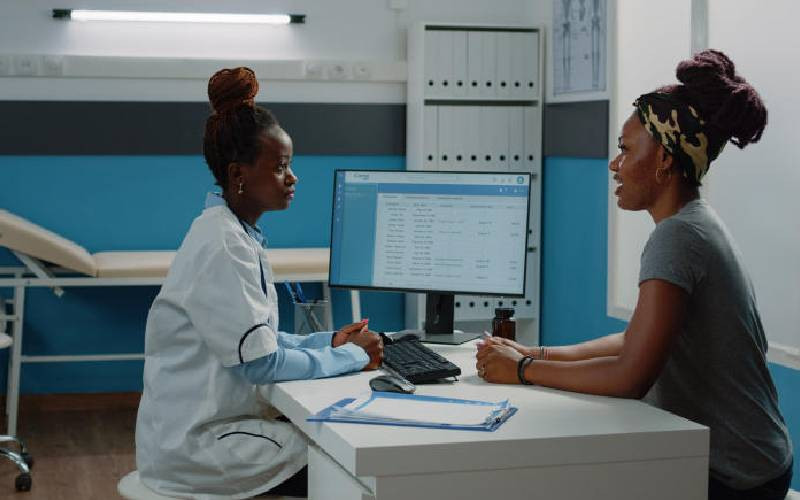It is a vaccine-preventable cancer, yet it is the leading cause of death in women in the developing world, writes NJOKI CHEGE
In 2009, more than 500,000 women were diagnosed with cervical cancer and more than 270,000 died from it worldwide. Of these women, 85 per cent were in Sub-Saharan Africa.
Cervical cancer starts in the cervix, the lower part of the uterus (womb) that opens at the top of the vagina. Cancer of the cervix is a slow growing cancer taking more than 10 years to change from its pre-cancerous stage to the full-blown cancer.
According to Dr Brigid Monda, a consultant obstetrician and gynaecologist, in Nairobi the main cause of this curable cancer is certain strains of the Human Papilloma Virus (HPV), which also causes genital warts.
"HPV is the most common sexually transmitted infection, more common than gonorrhoea or syphilis. It is highly contagious, spreading easily through skin-to-skin genital contact and penetrative sex. Although condoms reduce the risk, they are not completely protective," she says.
The risk factors to getting infected with HPV are mainly sexual. They include sex and first pregnancy at an early age, having many pregnancies, which damage the cervix, multiple sexual partners or women in polygamous marriages; other sexually transmitted infections like Herpes and HIV can also expose one to the infection.
Dr Monda explains that our immune system is able to get rid of HPV in more than 90 per cent of those infected within nine to 15 months. The infection persists in the remaining ten per cent and these are the women at risk of developing cervical cancer.
HPV virus has a special attraction for the cells of the cervix and once the virus is introduced into the genital tract, it inserts itself into the DNA of the dividing cervical cells, altering their coding and causing them to divide abnormally producing defective cells. Over the years, these defective cells become cancerous.
These changes are microscopic and cannot be felt or sensed by the patient until it is too late. That is why early detection through testing for the HPV virus or Pap smear screening and vaccination against HPV infection are very important. "The pre-cancerous stages of cervical cancer have no symptoms. The only way you can protect yourself from this disease is by having your pap smears done regularly. You should not wait for symptoms of cervical cancer because you are most likely be at an advanced stage of the disease and your chances of survival could be greatly reduced," says Dr Monda.’
The Pap test
Named after its developer, George Papanicolaou, the Pap smear is a screening test for cervical cancer and ranks among the top success stories of modern medicine because it has saved many lives.
"It detects early cancerous changes in the cervical cells and when treated early, cervical cancer is absolutely curable," says Monda.
The general guideline is that your first pap smear should be done within three years of your first sexual encounter or from age18 to 21 — whichever comes first but not later than age 21. The Pap smear should then be done annually for the first two years and if these two are normal, then it can be done every two years until the age of 40 then yearly after this.
The Kenya national guideline from the Ministry of Health is to have a pap smear done yearly for three years and if negative, to then have it done every five years.
A pap smear picks up the abnormal cells when the disease is easily treatable. A second examination called a Colposcopy is done if your Pap smear shows abnormal cells to confirm the diagnosis and involves examining the cervix using a Colposcope, an instrument that illuminates and magnifies the cervix and samples of any abnormal cells. Once treated you will need regular pap smears thereafter.
Stay informed. Subscribe to our newsletter
Success rates are virtually 100 per cent so long as the treatment is given at the pre-cancerous stage.
Virgins, women over 70 years, who have had three normal pap tests in a row in the last ten years and women who have had hysterectomies for non-cancerous conditions like fibroids do not require pap smears.
If indeed you have cancer and it is detected in the early stages, it is relieving to know that it is treatable through surgery.
Treatment
Treatment of cervical cancer depends on the stage of the cancer, the size and shape of the tumour, age and general health of the woman and her desire to have children in the future.
Removing or destroying the pre-cancerous or cancerous tissue can cure early cervical cancer. There are surgical ways to do this without removing the uterus or damaging the cervix, so that a woman can still have children in the future.
The vaccine
The vaccine mainly protects against the most dangerous strains of cancer causing HPV. It is recommended for girls from the age of nine to 16, before they become sexually active and also for women up to the age of 55 because one cannot be sure when you may be exposed to the virus during your sexually active years.
Alison Welton, the chief radiographer at Cancer Care Kenya Centre, explains that the vaccine is useful to protect against certain strains of the HPV virus, with no side effects.
"If you are sexually active, the efficacy of this vaccine is reduced, because the sexual activity has exposed the woman to the virus," she says.
Welton advises women who are sexually active to go for the vaccine as well, although they first need to get checked for the HPV virus to be advised accordingly. For women who are not sexually active, this vaccine guarantees almost 100 per cent protection.
Welton says it is important for women who have received the vaccine to follow it up with frequent Pap smear tests.
The vaccine is available in most medical centres and goes for Sh2,500 or more, depending on where you get it.
The HPV test
This new test is recommended for sexually active women over the age of 30 when HPV infections are more likely to be persistent. While HPV infection is common in women below 30, it usually goes away on its own or is cleared by the immune system before it causes any problems.
Doctors recommend that women aged 30 and above get a regular HPV test along with their pap regardless of their earlier pap results because the test detects the cancer causing HPV virus even when the Pap smear is normal. I
It can also be done for women with genital warts and for women below the age of 30, who have done a pap smear and the lab is unable to tell whether the pap is normal or not.
The HPV test quickly determines if you have the high-risk type of HPV and need further tests to catch any abnormal cells that need treatment.
It is vital to do the Pap smear and the HPV test because both look for different ‘clues’ — the HPV test looks for the genetic footprint of the HPV virus and the Pap smear looks for abnormal cells. The HPV test will tell whether or not you have one or more of the cancer causing high-risk types of HPV.
The test, which is available locally, can tell whether you have one or more of the 13 high-risk cancer-causing strains of HPV.
Since this disease could be traumatising to the patient, patients are asked to join support groups to share experiences and ease the burden.
Additional sources: www.righthealth.com
 The Standard Group Plc is a
multi-media organization with investments in media platforms spanning newspaper
print operations, television, radio broadcasting, digital and online services. The
Standard Group is recognized as a leading multi-media house in Kenya with a key
influence in matters of national and international interest.
The Standard Group Plc is a
multi-media organization with investments in media platforms spanning newspaper
print operations, television, radio broadcasting, digital and online services. The
Standard Group is recognized as a leading multi-media house in Kenya with a key
influence in matters of national and international interest.
 The Standard Group Plc is a
multi-media organization with investments in media platforms spanning newspaper
print operations, television, radio broadcasting, digital and online services. The
Standard Group is recognized as a leading multi-media house in Kenya with a key
influence in matters of national and international interest.
The Standard Group Plc is a
multi-media organization with investments in media platforms spanning newspaper
print operations, television, radio broadcasting, digital and online services. The
Standard Group is recognized as a leading multi-media house in Kenya with a key
influence in matters of national and international interest.









